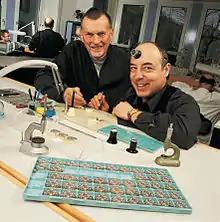Ludwig Oechslin | |
|---|---|
 | |
| Born | February 10, 1952 Gabicce Marie, Italy |
| Nationality | Swiss |
| Education | PhD in Philosophy from the University of Bern |
| Occupation(s) | Watchmaker, designer, inventor |
Ludwig Oechslin (born February 10, 1952) is a Swiss watchmaker, designer and inventor.
Life
Ludwig Oechslin was born in Gabicce Mare. In 1972, he embarked upon a degree course in archaeology at the University of Basel, Switzerland, going on to graduate in 1976. In 1983 was awarded a PhD in Philosophy, specialising on the history of Research, and received a scholarship to study theoretical physics and astronomy at the University of Bern, Switzerland. Parallel to these studies, he also studied to become a watchmaker and was awarded a diploma as a Swiss master watchmaker in 1993. In 1995 Oechslin habilitatiated in Pre-Industrial Technical Archaeology at the Swiss Federal Institute of Technology Zurich (ETHZ), Switzerland.[1]
Oechslin is married with three children.
Work
Ludwig Oechslin got widely known for this restoration of the astronomical clock in the Vatican Library, known as the Farnese Clock, and for the time he spent as Director of the International Museum of Horology in La Chaux-de-Fonds, Switzerland (2011-2014). During this period, he managed the project leading to the release of the MIH watch by the International Museum of Horology.[2][3]
Oechslin also constructed a replica of the Antikythera Mechanism[4] and developed the extremely complicated astronomical Türler Clock, which was built between 1986 and 1995 by Jörg Spöring for Türler Uhren & Juwelen jewelers in Zurich,[5][6][7] Switzerland. Since 2018 the Türler Clock has been on display at the International Museum of Horology.
In the early 1980s Oechslin started to work for Ulysse Nardin, where he developed numerous watches, including the Freak model, which went on to gain international acclaim.[8][9]
He also designed the Astrolabium Galileo Galilei wristwatch, mentioned in 1989 in the Guinness Book of World Records as the most complex watch ever made.[10][11] In 2006 Oechslin founded his own watch company Ochs und junior in Lucerne, Switzerland, together with his partner Beat Weinman.[12] Oechslin currently collaborates with a number of universities such as ETH Zürich and the Université de Neuchâtel, and is a member of the jury of multiple organizations.[13][14][15]
Awards
2023: Ludwig Oechslin's «Freak» was awarded the «Iconic Watch Price» of the GPHG[16]
2016: Hommage à la Passion of the Swiss Foundation High Horology[17]
2009: Special Jury Prize at the Grand Prix d'Horlogerie de Genève[18]
1995: Prix Gaïa (histoire-recherches) of the International Museum of Horology[19]
1989: At the end of the 1980s Ludwig Oechslin developed the «Astrolabium Galileo Galilei» for Ulysse Nardin gaining the company an entry into the Guiness Book of Records 1988/89. [20][21]
References
- ↑ "About Ludwig Oechslin (ETH Zürich; in German)".
- ↑ "MIH Watch". Embassy. Retrieved 2019-02-10.
- ↑ "MIH Watch Review". aBlogtoWatch. 2013-01-18. Retrieved 2019-02-10.
- ↑ "Antikythera mechanism (in German)" (PDF).
- ↑ "Turler clock". people.timezone.com. Retrieved 2019-02-10.
- ↑ "Türler Watches & Jewelry in Zürich celebrates 130 years. A photo reportage with surprises in three parts ... – Page 3 of 3". Watch-Insider.com. 2013-02-07. Retrieved 2019-02-10.
- ↑ "Türler Uhr - Türler Schmuck und Uhren". Türler Schmuck & Uhren (in Swiss High German). Retrieved 2019-02-10.
- ↑ "History - Fondation de la Haute Horlogerie". www.hautehorlogerie.org. Retrieved 2019-02-10.
- ↑ Forster, Jack (May 2, 2018). "Hands-On: The Ulysse Nardin Freak 'Freak Out' Full Black". Hodinkee. Retrieved 2019-02-10.
- ↑ "Portrait of Ludwig Oechslin". Ulysse Nardin. 2017-08-09. Retrieved 2019-02-10.
- ↑ Loughborough University about Astrolabium (PDF). Loughborough University. January 2013. ISBN 9781907382727.
- ↑ "About". ochs und junior. Retrieved 2019-02-10.
- ↑ "GPHG Jury 2017". 29 April 2017.
- ↑ "History of Technology : WS 1998/1999 Wissenssysteme in der Gesellschaft". www.tg.ethz.ch. Retrieved 2019-02-10.
- ↑ "Prix GaÏa Jury" (PDF).
- ↑ "Iconic Watch Prize of the GPHG".
- ↑ ""Hommage au Talent" and "Hommage à la Passion" 2016 - Fondation de la Haute Horlogerie". www.hautehorlogerie.org. Retrieved 2019-02-10.
- ↑ "DGHG" (PDF).
- ↑ "Ville de La Chaux-de-Fonds". www.chaux-de-fonds.ch (in French). Retrieved 2019-02-10.
- ↑ "Entry in the Guinness Book of Records".
- ↑ "Entry in the Guiness Book of Records".
External links
- Interview with Dr. Oechslin on Fifthwrist-Radio (Podcast)
- Foundation High Horology about Ludwig Oechslin
- Ludwig Oechslin in watch-wiki
- Ludwig Oechslin in the catalogue of the German National Library (in German)
- The Art of Living profile of Ludwig Oechslin
- EuropaStar article about Ludwig Oechslin
- WatchTime article profile of Ludwig Oechslin
- UBS Magazine article about Ludwig Oechslin
- RobbReport article about Ludwig Oechslin
- New York Times article about Oechslin's watches